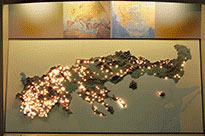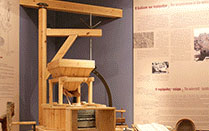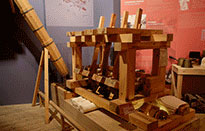

The exhibition is designed to familiarise the public with the water-powered machines that replaced the hand tools (hand mills, handsaws, mallets) used for centuries to grind grain, saw wood and finish cloth. It attempts to demonstrate the inventive genius that lay behind these water-powered machines, which were devised to reduce the heavy burden of manual labour. It also tries to explain the social and economic conditions that favoured their widespread adoption and illustrate the dynamics of the new technologies: technology, in other words, is here approached through its human dimension.
Finally, the visitor can follow the application of the principles underlying the working of these wooden machines in a modern internal combustion engine, and understand their importance to the development of technology.
In restoring the lost prestige of all water-driven machines, scattered all across the Northern Greek countryside, and through the reconstitutions of the life of the miller, the sawyer, the fuller, it becomes obvious why these centres are cultural and technological monuments, well worthy of study and preservation. Traditional technology, then, assumes the place it merits in a modern folklife museum.
Visitors to the exhibition will learn about the historical framework of the period (18th c. - mid 20th c.) and see, on a push-button relief map of Macedonia and Thrace, where these watermills used to be and which ones are still in working order. They will see exhibits of museum pieces (hand tools) and watch water-powered machines at work -the gristmill grinds grain, the sawmill rips up logs, the waterfall and fulling mill pound the woollen cloth.
Smaller models (Vitruvius' 1st c. BC watermill and Honnecourt's 13th c. sawmill) illustrate the first known complex machines, while a hand mill lets the visitor try his hand at grinding grain into flour.






 Follow us
Follow us 



